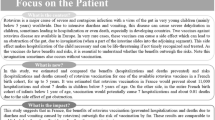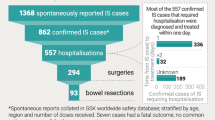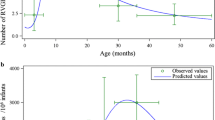Abstract
Background: The use of live oral poliomyelitis vaccine (OPV) has led to the elimination of poliomyelitis disease in many countries since licensure in 1960. The discovery of an increased risk of an intestinal obstruction known as intussusception following live rotavirus vaccination raised questions about the possibility of a link between live OPV and intussusception. Methods: Three self-controlled case-series studies were carried out. The first was exploratory and included 218 intussusception episodes from hospital admissions data linked to vaccination records in the Thames region. The two subsequent studies, which used further hospital admissions data and the General Practice Research Database (GPRD) included 107 and 198 episodes respectively and were used to test hypotheses generated in the first study. Results: In the exploratory study risk periods of up to 6 weeks after each dose were examined. The only period with some evidence of an increased risk was the 14–27-day period after the third dose (relative incidence (RI) = 1.97, p = 0.011). The second hospital admissions study and the GPRD study showed no evidence of an increased relative incidence in any putative risk period and did not confirm the increased risk in the 14–27-day period after dose 3 with a combined RI of 1.03. Conclusions: The sequence of studies does not support the hypothesis that OPV causes intussusception. The increased RI in the first study may be explained as a chance finding due to the number of risk periods examined and highlights the need for caution when looking at many risk periods without an a priori hypothesis.
Similar content being viewed by others
References
Robbins F. Polio-Historical. In: Plotkin S, Mortimer E (eds), Vaccines, second edn, Philadelphia/London/Toronto/ Montreal/Sydney/Tokyo: Saunders Company, 1988: 137–154.
Murphy TV, Gargiullo PM, Massoudi MS, et al. Intussusception among infants given an oral rotavirus vaccine. N Eng J Med 2001; 344: 564–572.
Anon. Weekly Epidemiological Record 2000; 75: 345–347.
Miller E, Waight P, Farrington P. Safety assessment post-licensure. Dev Biol Stand 1998; 95: 235–243.
Farrington CP, Nash J, Miller E. Case-series analysis of adverse reactions to vaccines: A comparative study. Am J Epidem 1996; 143: 1165–1173.
Lawson DH, Sherman V, Hollowell J. The General Practice Research Database. Q J Med 1998; 91: 445–452.
Walley T, Mantgani A. The UK General Practice Research Database. Lancet 1997; 350: 1097–1099.
Nash JQ, Chandrakumar M, Farrington CP, Williamson S, Miller E. Feasibility study for routine surveillance by record linkage of adverse events attributable to vaccination. Epidemiol Infect 1995; 114: 475–480.
C.P. Farrington. Relative incidence estimation from case-series for vaccine safety evaluation. Biometrics 1995; 51: 228–235. Address for correspondence: N.J. Andrews, Public Health Laboratory Service Statistics Unit, 61 Colindale Avenue, London NW95EQ, United Kingdom Phone: +44-20-82006868; Fax: +44 20-82007868 E-mail: nandrews@phls.org.uk 706
Author information
Authors and Affiliations
Rights and permissions
About this article
Cite this article
Andrews, N., Miller, E., Waight, P. et al. Does oral polio vaccine cause intussusception in infants? Evidence from a sequence of three self-controlled cases series studies in the united kingdom. Eur J Epidemiol 17, 701–706 (2001). https://doi.org/10.1023/A:1015691619745
Issue Date:
DOI: https://doi.org/10.1023/A:1015691619745




